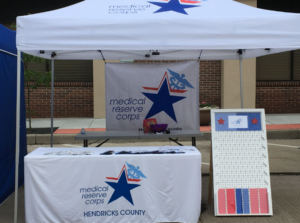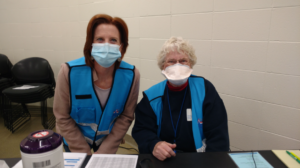Hendricks County Leaders Focus in on Emergency Preparedness
Do you know if Hendricks County is ready in the event of a large-scale emergency? Leaders in the community have been working on emergency preparedness, particularly since September 11, 2001.
According to Jeff Corder, emergency preparedness coordinator for Hendricks County, when volunteers showed up in New York City on September 11 and the days after, there wasn’t an established way to organize them or utilize their various services.
In 2002, former President George W. Bush approved a national Citizen Corps, with several different arms or departments under the main umbrella. One of the groups under that umbrella was the Medical Reserve Corps (MRC), in which Corder also serves as coordinator for the county.
“The MRC is an emergency response team that supplements for medical first responders, but the name actually misleads people,” Corder says. “You don’t have to be trained in the medical field. Think about the pandemic. We needed people helping with registration, people greeting, organizing, etcetera. We’re volunteers that supplement the health department staff so they can give vaccinations or dispense medication.”
The MRC was formed in Hendricks County in 2007, and just prior to COVID, the group belonged to a list of 75 volunteers. After COVID, that list grew to 215.
“Over two and a half years, [during the pandemic] we volunteered at clinics,” Corder says. “We have a lot of retired nurses and doctors, and veterans trained in the military, and COVID showed what we could do best – staff the clinics or points of dispensing.”
As the pandemic waned, members of the MRC began looking for other ways to volunteer on a regular basis.
Educational and medical assistant training opportunities are offered throughout the year and range from STOP THE BLEED programs, CPR, psychological first aid and more.
Corder plans to host a training in 2024 for creating a family assistance center or shelter. During a mass emergency, family members are transported to hospitals, pets are lost and located in another area, and there may even be fatalities. The assistance or command center would be a central place where residents could gather to locate and receive information about their loved one. All of that takes volunteers, and a lot of them.
Through a Leadership Hendricks County Capstone Project, the Crisis Response Team (CRT) was formed as a subgroup under the MRC.
Bridgette Collins-George is the executive director of Hendricks County Community Corrections. She’s also a member of the MRC and CRT.
“CRT is a group of trained volunteers in the National Organization for Victim Assistance model,” Collins-George says. “We’re like a second layer of first responders.”
The group’s goal is to meet the basic needs of individuals who have experienced a traumatic situation. For example, when an employer or superintendent says additional support has been brought in for those who need to talk about a recent suicide or drug overdose, the CRT could be one of those additional support units.
“We’re really there to bridge the gap, not only to give people a voice and chance to speak, but also to connect them to resources,” Collins-George says. “When you have a traumatic event, you can have trouble focusing and finding the right place to connect.”
The goal for Corder is to continue to add to the list of those he can call on in an emergency. However, there are many ways the MRC and CRT can help all year long. In the fall, Hendricks County Health Department representatives travel to schools and nursing homes to administer vaccines. Businesses request free training for employees year-round, and there is a constant need to train new individuals as CRT or STOP THE BLEED instructors.
Volunteers can choose to stay on the list for potential involvement in significant emergencies or opt to participate in various training sessions and contribute to addressing smaller yet crucial community needs—considering options such as obtaining a bbp certification to enhance their preparedness and impact.

“It’s important that we have an organized system for our volunteers,” Corder says. “If there’s ever a large-scale event, we want to have a way to operate a reception center and shelter to check people in, park cars, serve as translators and organize information.”
For anyone who feels like they aren’t a people person, Corder is also working with a local animal shelter to create plans to care for pets during a large-scale event.
“There isn’t a specific time commitment,” Corder says. “Volunteers have to have a background check every two years. The most common question we receive is, ‘I don’t have a medical background. What can I do?’ While there are a lot of untapped medical professionals out there, like dentists and veterinarians whose expertise could be utilized, we are really in need of just about anything people want to do that doesn’t involve a medical procedure.”
Anne Archer, community outreach coordinator for the Hendricks County Health Department, says staff relies on services provided by the MRC and CRT.
“I think a lot of people aren’t aware of all the things we do at the Health Department,” Archer says. “For example, we offer vaccine clinics, monitor communicable diseases and strive to keep our communities healthy.”
When it comes to large crises, volunteers make a huge difference.
“Our COVID vaccine clinic response would not have been the same without them,” Archer says.
For more information, visit hendrickscountymrc.org.




